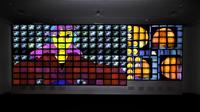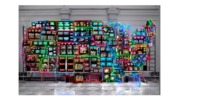Items
Tag
Object
-
 Megatron/Matrix Megatron Matrix is roughly the size of a billboard and holds 215 monitors. The video—augmented by a loop of unrelated soundbites—mixes images from the Seoul Olympics with Korean folk rituals and modern dance. Smaller clips play simultaneously on multiple monitors, while larger, animated images flow across the boundaries between screens, suggesting a world without borders in the electronic age. Paik sorted the monitors into two distinct sections. The Megatron conveys the vast reach of the media, while the smaller section, the Matrix, emphasizes the impact on each of us. In Matrix, Paik arranged the monitors so that the images seem to spiral inward around a lone screen showing two partially nude women. He may be suggesting that our bodies are our primal connection to the world, but the effect on the viewer is of being assaulted by "too much information." In the early 1960s, Paik began incorporating televisions into his collaborative performance pieces with American dancers, musicians, and artists. Today, the fusion of pop music, commercial culture, and nationalist symbols captures Paik's story and that of millions around the world. Paik's prophetic awareness of the power of television has been borne out in our "plugged-in" age, when any kind of art or entertainment is available on our screens all the time.
Megatron/Matrix Megatron Matrix is roughly the size of a billboard and holds 215 monitors. The video—augmented by a loop of unrelated soundbites—mixes images from the Seoul Olympics with Korean folk rituals and modern dance. Smaller clips play simultaneously on multiple monitors, while larger, animated images flow across the boundaries between screens, suggesting a world without borders in the electronic age. Paik sorted the monitors into two distinct sections. The Megatron conveys the vast reach of the media, while the smaller section, the Matrix, emphasizes the impact on each of us. In Matrix, Paik arranged the monitors so that the images seem to spiral inward around a lone screen showing two partially nude women. He may be suggesting that our bodies are our primal connection to the world, but the effect on the viewer is of being assaulted by "too much information." In the early 1960s, Paik began incorporating televisions into his collaborative performance pieces with American dancers, musicians, and artists. Today, the fusion of pop music, commercial culture, and nationalist symbols captures Paik's story and that of millions around the world. Paik's prophetic awareness of the power of television has been borne out in our "plugged-in" age, when any kind of art or entertainment is available on our screens all the time. -
 Electronic Superhighway: Continental U.S., Alaska, Hawaii When Nam June Paik came to the United States in 1964, the interstate highway system was only nine years old, and superhighways offered everyone the freedom to "see the U.S.A. in your Chevrolet." Walking along the entire length of this installation suggests the enormous scale of the nation that confronted the young Korean artist when he arrived. Neon outlines the monitors, recalling the multicolored maps and glowing enticements of motels and restaurants that beckoned Americans to the open road. The different colors remind us that individual states still have distinct identities and cultures, even in today's information age. Paik augmented the flashing images "seen as though from a passing car" with audio clips from The Wizard of Oz, Oklahoma, and other screen gems, suggesting that our picture of America has always been influenced by film and television. Today, the Internet and twenty-four-hour broadcasting tend to homogenize the customs and accents of what was once a more diverse nation. Paik was the first to use the phrase "electronic superhighway," and this installation proposes that electronic media provide us with what we used to leave home to discover. But Electronic Superhighway is real. It is an enormous physical object that occupies a middle ground between the virtual reality of the media and the sprawling country beyond our doors.
Electronic Superhighway: Continental U.S., Alaska, Hawaii When Nam June Paik came to the United States in 1964, the interstate highway system was only nine years old, and superhighways offered everyone the freedom to "see the U.S.A. in your Chevrolet." Walking along the entire length of this installation suggests the enormous scale of the nation that confronted the young Korean artist when he arrived. Neon outlines the monitors, recalling the multicolored maps and glowing enticements of motels and restaurants that beckoned Americans to the open road. The different colors remind us that individual states still have distinct identities and cultures, even in today's information age. Paik augmented the flashing images "seen as though from a passing car" with audio clips from The Wizard of Oz, Oklahoma, and other screen gems, suggesting that our picture of America has always been influenced by film and television. Today, the Internet and twenty-four-hour broadcasting tend to homogenize the customs and accents of what was once a more diverse nation. Paik was the first to use the phrase "electronic superhighway," and this installation proposes that electronic media provide us with what we used to leave home to discover. But Electronic Superhighway is real. It is an enormous physical object that occupies a middle ground between the virtual reality of the media and the sprawling country beyond our doors. -
 Technology
Technology -
 Untitled gem “Gem of glass paste imitating sard, engraved with Herakles with a bow, lion-skin and club; before him sits Prometheus, draped about the legs, with his hands chained above his head.”
Untitled gem “Gem of glass paste imitating sard, engraved with Herakles with a bow, lion-skin and club; before him sits Prometheus, draped about the legs, with his hands chained above his head.” -
 Untitled scarab “Sard cut scarab engraved with a seated Prometheus making man: he attaches an arm to a skeleton. There is an inscription.”
Untitled scarab “Sard cut scarab engraved with a seated Prometheus making man: he attaches an arm to a skeleton. There is an inscription.”